
A semi-automatic pistol is a handgun that automatically ejects and loads cartridges in its chamber after every shot fired. Only one round of ammunition is fired each time the trigger is pulled, as the pistol's fire control group disconnects the trigger mechanism from the firing pin/striker until the trigger has been released and reset.
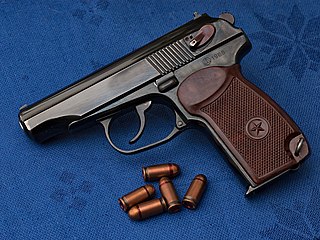
The Makarov pistol or PM is a Soviet semi-automatic pistol. Under the project leadership of Nikolay Fyodorovich Makarov, it became the Soviet Union's standard military and Militsiya side arm in 1951.

The Walther P99 is a semi-automatic pistol developed by the German company Carl Walther GmbH Sportwaffen of Ulm for law enforcement, security forces and the civilian shooting market as a replacement for the Walther P5 and the P88. The P99 and its variants are also made under licence by Fabryka Broni Radom.

The SIG Sauer P220 is a semi-automatic pistol designed in 1975 by the SIG Arms AG division of Schweizerische Industrie Gesellschaft, and produced by J. P. Sauer & Sohn, in Eckernförde. It is currently manufactured by both SIG Sauer companies: SIG Sauer GMBH, of Eckernförde, Germany; and SIG Sauer, Inc., of New Hampshire, United States.

The Nambu pistols are a series of semi-automatic pistols produced by the Japanese company Koishikawa Arsenal, later known as the Tokyo Artillery Arsenal. The series has three variants, the Type A, the Type B, and the Type 14. The Nambu pistols were designed to replace Japan's earlier service pistol, the Type 26 revolver.

The M1901 Mannlicher Self-Loading, Semi-Automatic Pistol was an early semi-automatic pistol design. The Bundeswehr Museum of German Defense Technology in Koblenz has one of these specimen in its collection.
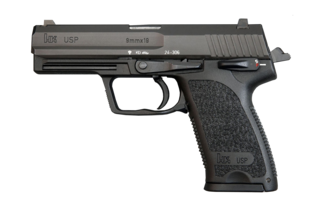
The USP is a semi-automatic pistol developed in Germany by Heckler & Koch GmbH (H&K) as a replacement for the P7 series of handguns.

The Heckler & Koch P2000 is a German semi-automatic pistol introduced late in 2001 and intended primarily for law enforcement, paramilitary, and commercial markets. It is based on the USP Compact pistol. The P2000 was designed specifically with improved ergonomic characteristics; it has features that reduce handling related stresses, while at the same time increasing user handling and comfort.

The Heckler & KochP7 is a German 9×19mm semi-automatic pistol designed by Helmut Weldle and produced from 1979 to 2008 by Heckler & Koch GmbH (H&K). The P7M13, a variant of the P7 with a double-stack magazine, was produced until 2000.

The WIST-94 is a semi-automatic pistol produced in Poland.

The Type 94 Nambu 8 mm pistol is a semiautomatic pistol developed by Kijirō Nambu and his associates for the Imperial Japanese Army. Development of the Type 94 pistol began in 1929, and after several redesigns the final prototype was tested and officially adopted by the Japanese army in late 1934. The Type 94 pistol entered production in 1935. Approximately 71,000 pistols were manufactured before production ended in 1945.

The Sauer 38H or often just H was a small semi-automatic pistol made in Nazi Germany from 1938 until just after the end of World War II by J. P. Sauer & Sohn, then based in Suhl, Germany. The "H" in the model number is short for "hahn", referring to the internal hammer of the firing mechanism.

A trigger is a mechanism that actuates the function of a ranged weapon such as a firearm, airgun, crossbow, or speargun. The word may also be used to describe a switch that initiates the operation of other non-shooting devices such as a trap, a power tool, or a quick release. A small amount of energy applied to the trigger leads to the release of much more energy.

The Vzor 45, commonly known as CZ 45 is a compact blowback operated semi-automatic pistol chambered in .25 ACP. It was made in Czechoslovakia and later in the Czech Republic. Derived from the CZ-36 following World War II, the CZ-45 is currently manufactured by Česká zbrojovka Uherský Brod as the CZ-92.

The Semmerling LM4 is a five-shot, manually repeating double-action pocket pistol.
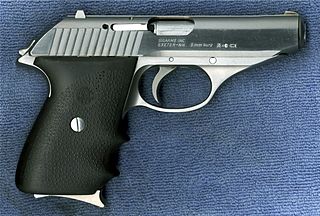
The SIG Sauer P230 is a small, semi-automatic handgun chambered in .32 ACP or .380 Auto. It was designed by SIG Sauer of Eckernförde, Germany. It was imported into the United States by SIGARMS in 1985. In 1996 it was replaced by the model P232.
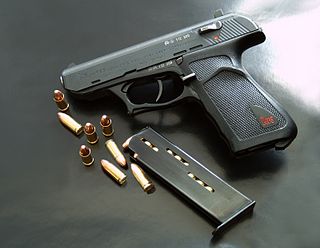
The HK P9 is a semi-automatic pistol from Heckler & Koch in 9×19mm Parabellum, .45 ACP, and 7.65×21mm Parabellum and the first to use a variation of H&K's roller delayed blowback system in a pistol format and polygonal rifling now common in H&K designs.

In firearms, a safety or safety catch is a mechanism used to help prevent the accidental discharge of a firearm, helping to ensure safer handling.

The Walther PPQ is a semi-automatic pistol developed by the German company Carl Walther GmbH Sportwaffen of Ulm for law enforcement, security forces and the civilian shooting market as a development of the Walther P99. It is available in 9×19mm Parabellum, 9×21mm, .40 S&W, and .45 ACP chamberings.
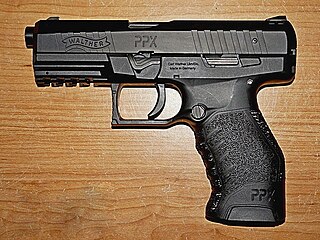
The Walther PPX and the Walther Creed semi-automatic pistols were developed by the German company Carl Walther GmbH Sportwaffen of Ulm as low-cost duty handguns. The PPX was available in 9×19mm Parabellum and .40 S&W. Its successor, the Creed, was available only in 9mm.



















